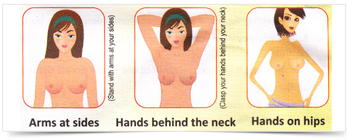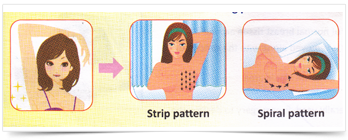
Breast self-examination (BSE) is a screening method used in an attempt to detect early breast cancer. The method involves the woman herself looking at and feeling each breast for possible lumps, distortions or swelling.

An pictorial example of breast self-examination in six steps.
Steps 1-3 involve inspection of the breast with the arms hanging next to the body, behind the head and in the side.
Step 4 is palpation of the breast.
Step 5 is palpation of the nipple.
Step 6 is palpation of the breast while lying down.

If you notice any of the following changes in your breasts, notify your doctor as soon as possible. Possible signs and symptoms of breast cancer include:
Changes in the nipple:
Changes in the appearance of the breast:
Breast pain (mastalgia) is the most common breast related complaint among women; nearly 70% of women experience breast pain at some point in their lives. Breast pain may occur in one or both breasts or in the underarm (axilla) region of the body. The severity of breast pain varies from woman to woman; approximately 15% of women require treatment. Though breast pain is not normally associated with breast cancer, women who experience any breast abnormalities, including breast pain, should consult their physicians.
Women should report all complaints of persistent breast pain to their doctor. Physicians will evaluate the pain, taking into account the woman's personal history, family history, the area of pain, the intensity and duration of the pain, and the extent to which the pain interferes with her lifestyle.
Physicians will also perform clinical breast examinations, and if necessary, order additional breast imaging exams (such as mammography or ultrasound) to help determine whether the pain is related to another breast condition or possibly cancer. If no breast abnormality is indicated, the physician and woman should decide together whether drug treatment is necessary.
Breast lumps are localized swellings that feel different from the surrounding breast tissue. It is a symptom/sign for a variety of conditions. As approximately 10% of breast lumps ultimately lead to a diagnosis of breast cancer,it is important for women with a breast lump to receive appropriate evaluation.
Breast lumps are often discovered during a breast self-examination or during a routine check-up. Upon noticing an unusual lump in the breast the best course of action is to schedule an examination with a physician who can best diagnose the type of breast lump and strategy for treatment.
Patients should make sure that the medical records of any breast-related illnesses are retained,as this facilitates diagnosis in case of recurrence or follow-up.
Nipple discharge refers to any fluid that seeps out of the nipple of the breast. Nipple discharge in a woman who's not pregnant or breast-feeding isn't necessarily abnormal, but it should be evaluated by a doctor. Nipple discharge in a man under any circumstances could be a problem and needs further evaluation.
Breast cancer is cancer that develops from breast tissue. Breast cancer develops from a cancerous cell which develops in the lining of a duct or lobule in one of the breasts.
Signs of breast cancer may include a lump in the breast, a change in breast shape, dimpling of the skin, fluid coming from the nipple, or a red scaly patch of skin.In those with distant spread of the disease, there may be bone pain, swollen lymph nodes, shortness of breath, or yellow skin.
Other symptoms which may be noticed in the affected breast include:
The first place that breast cancer usually spreads to is the lymph glands (nodes) in the armpit (axilla). If this occurs, you may develop a swelling or lump in an armpit. If the cancer spreads to other parts of the body then various other symptoms can develop.
Evaluation of breast cancer includes the following:
If a palpable lump is found and possesses any of the following features, breast cancer may be present:
Early detection remains the primary defense in preventing breast cancer. Screening modalities include the following:
Enter your details below & we will call you back